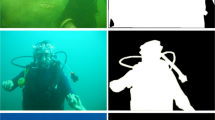Abstract
The semantic segmentation approach is essential in automated scene analysis, but its application in underwater environments is still limited. Datasets generally have insufficient labeled data, unbalanced data classes, and different lighting conditions, making it difficult to obtain optimal results. Currently, deep convolutional neural networks allow very good results in machine vision tasks, and one of the network architectures with good performance in semantic segmentation is DeepLabv3 + . This paper evaluates the performance of DeepLabv3 + and transfer learning based on pre-trained backend networks in ImageNet to study underwater scenes. The experimentation is carried out on a dataset available on the Internet with labels of eight classes. Experimental results show that DeepLabv3 + and transfer learning are effective for semantic segmentation of multiple underwater scene objects with insufficient tagged data and unbalanced classes.
Access this chapter
Tax calculation will be finalised at checkout
Purchases are for personal use only
Similar content being viewed by others
References
Danovaro R et al (2016) Implementing and innovating marine monitoring approaches for assessing marine environmental status. Front Mar Sci 3
Patil PW, Thawakar O, Dudhane A, Murala S (2019) Motion saliency based generative adversarial network for underwater moving object segmentation. In: 2019 IEEE international conference on image processing (ICIP). IEEE, pp 1565–1569
Liu F, Fang M (2020) Semantic segmentation of underwater images based on improved Deeplab. J Mar Sci Eng 8:188
Niemeijer J, PekezouFouopi P, Knake-Langhorst S, Barth E (2017) A review of neural network based semantic segmentation for scene understanding in context of the self-driving car. In: Student conference on medical engineering science. Infinite Science Publishing
Prados R, García R, Gracias N, Neumann L, Vågstøl H (2017) Real-time fish detection in trawl nets. In: OCEANS 2017—Aberdeen, pp 1–5
Garcia R, Prados R, Quintana J, Tempelaar A, Gracias N, Rosen S, V\aagstøl H, Løvall K (2020) Automatic segmentation of fish using deep learning with application to fish size measurement. ICES J Mar Sci 77:1354–1366
King A, Bhandarkar SM, Hopkinson BM (2018) A comparison of deep learning methods for semantic segmentation of coral reef survey images. In: Proceedings of the IEEE conference on computer vision and pattern recognition workshops, pp 1394–1402
Alonso I, Cambra A, Munoz A, Treibitz T, Murillo AC (2017) Coral-segmentation: training dense labeling models with sparse ground truth. In: Proceedings of the IEEE international conference on computer vision workshops, pp 2874–2882
Alonso I, Yuval M, Eyal G, Treibitz T, Murillo AC (2019) CoralSeg: learning coral segmentation from sparse annotations. J Field Robotics, 36(8), 1456–1477 (2019).
Chen LC, Zhu Y, Papandreou G, Schroff F, Adam H (2018) Encoder-decoder with atrous separable convolution for semantic image segmentation. In: Proceedings of the European conference on computer vision (ECCV), pp. 801–818
Chen L-C, Papandreou G, Schroff F, Adam H (2017) Rethinking Atrous convolution for semantic image segmentation. arXiv:1706.05587 [cs]
ImageNet, http://www.image-net.org/. Last accessed 11 Oct 2020
He K, Zhang X, Ren S, Sun J (2016) Deep residual learning for image recognition. In: 2016 IEEE conference on computer vision and pattern recognition (CVPR), pp 770–778
Chollet F (2017) Xception: deep learning with depthwise separable convolutions. In: 2017 IEEE conference on computer vision and pattern recognition (CVPR), pp 1800–1807
Sandler M, Howard A, Zhu M, Zhmoginov A, Chen L-C (2018) MobileNetV2: inverted residuals and linear bottlenecks. In: 2018 IEEE/CVF conference on computer vision and pattern recognition, pp 4510–4520
Islam MJ, Edge C, Xiao Y, Luo P, Mehtaz M, Morse C, Enan SS, Sattar J (2020) Semantic segmentation of underwater imagery: dataset and benchmark. In: IEEE/RSJ international conference on intelligent robots and systems (IROS), pp 1769–1776, Las Vegas, NV, USA
SUIM dataset, Interactive Robotics and Vision Lab. http://irvlab.cs.umn.edu/resources/suim-dataset. Last accessed 4 Aug 2020
Acknowledgements
This work has been supported by Programa Nacional de Innovación en Pesca y Acuicultura, PNIPA, Perú, Grant Nr. PNIPA-PES-SIA-PP-000004.
Author information
Authors and Affiliations
Corresponding author
Editor information
Editors and Affiliations
Rights and permissions
Copyright information
© 2022 The Author(s), under exclusive license to Springer Nature Singapore Pte Ltd.
About this paper
Cite this paper
Chicchon, M., Bedon, H. (2022). Semantic Segmentation of Underwater Environments Using DeepLabv3+ and Transfer Learning. In: Zhang, YD., Senjyu, T., So-In, C., Joshi, A. (eds) Smart Trends in Computing and Communications. Lecture Notes in Networks and Systems, vol 286. Springer, Singapore. https://doi.org/10.1007/978-981-16-4016-2_29
Download citation
DOI: https://doi.org/10.1007/978-981-16-4016-2_29
Published:
Publisher Name: Springer, Singapore
Print ISBN: 978-981-16-4015-5
Online ISBN: 978-981-16-4016-2
eBook Packages: Intelligent Technologies and RoboticsIntelligent Technologies and Robotics (R0)




